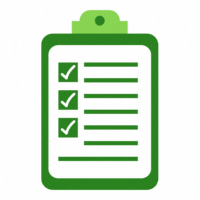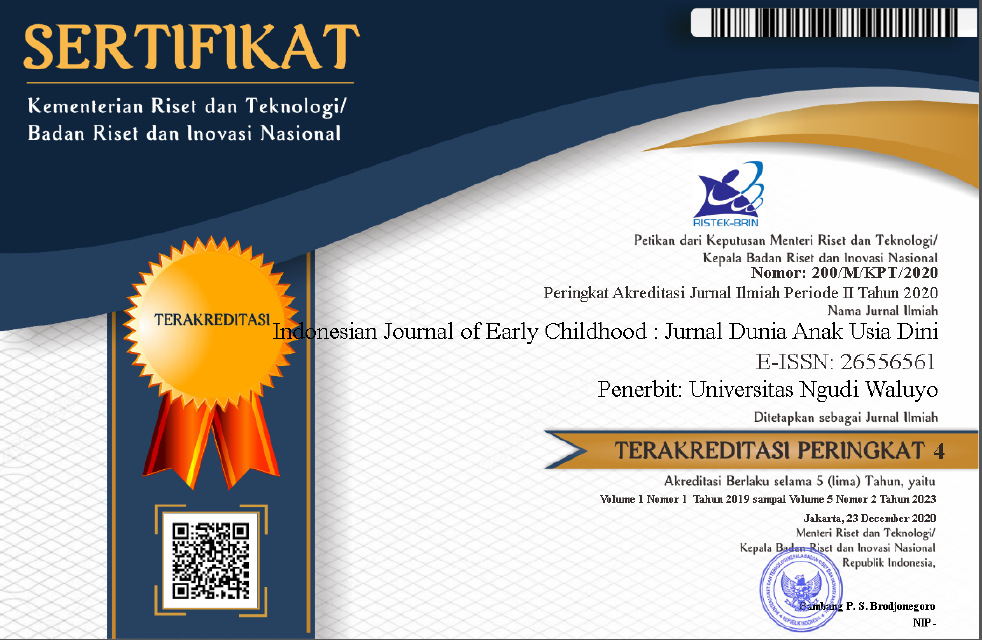Peran Media Digital terhadap Kemampuan Berbahasa Anak Usia Dini di Kober Al-Urwatul Wutsqa
The Role of Digital Media on Language Ability Early Childhood in Kober Al-Urwatul Wutsqa
DOI:
https://doi.org/10.35473/ijec.v6i1.2800Keywords:
Perkembangan Bahasa, Media DigitalAbstract
One indicator of development in early childhood is language development, however, a lack of stimulation for children can cause developmental disorders in early childhood. One of the stimulations in the digital era is the use of digital media, digital media is an audio-visual media which is calculated to be able to improve language skills in early childhood, where the use of digital media can help increase children's knowledge of vocabulary and color knowledge. , numbers, and text. This article aims to explain the role of digital media in early childhood language skills. Research on the role of digital media on young children's language skills uses a type of qualitative research in which data and information are obtained by collecting data through observation activities and case studies involving young children. The research results reveal that language skills in early childhood can be improved by using effective tools in the form of digital media, which need to be used wisely and under adult supervision. Language development in early childhood requires support from parents and educators by utilizing digital media, where in using digital media it is important to develop appropriate guidelines for parents and educators. Based on the previous explanation, it can be concluded that digital media has an important role as a development tool for young children, as long as it is used with full awareness of its impact and prioritizing healthy and in-depth social interactions in the language learning process.
ABSTRAK
Salah satu indikator perkembangan pada anak usia dini ialah perkembangan bahasa tetapi, dengan kurangnya stimulasi pada anak dapat menyebabkan gangguan perkembangan terhadap anak usia dini. Salah satu stimulasi di era digital ialah dengan pemanfaatan media digital, media digital merupakan suatu media audio visual yang diperhitungkan mampu meningkatkan kemampuan bahasa pada anak usia dini, yang mana dengan adanya pemanfaatan media digital dapat membantu dalam meningkatkan pengetahuan anak tentang kosa kata, pengetahuan terhadap warna, angka, dan teks. Artikel ini bertujuan untuk menjelaskan peran media digital terhadap kemampuan berbahasa anak usia dini. Penelitian peran media digital terhadap kemampuan berbahasa anak usia dini menggunakan jenis penelitian kualitatif yang mana dalam memperoleh data dan informasinya didapatkan dengan mengumpulkan data melalui kegiatan observasi dan studi kasus yang melibatkan anak usia dini. Hasil penelitian mengungkapkan bahwa kemampuan bahasa pada anak usia dini dapat ditingkatkan dengan menggunakan alat yang efektif berupa media digital, yang mana dalam penggunaannya perlu digunakan dengan bijak dan dalam pengawasan orang dewasa. Perkembangan bahasa pada anak usia dini perlu diberikannya dukungan dari orang tua dan pendidik dengan memanfaatkan media digital, yang mana dalam pemanfaatan media digital tersebut penting untuk mengembangkan pedoman yang tepat bagi orang tua dan pendidik. Berdasarkan penjelasan sebelumnya dapat disimpulkan bahwa media digital memiliki peran penting sebagai alat bantu perkembangan terhadap anak usia dini, asalkan dalam penggunaannya digunakan dengan penuh kesadaran akan dampaknya dan dengan mengutamakan interaksi sosial yang sehat dan mendalam dalam proses pembelajaran bahasa.
References
Fitria, N., Amelia, Z., & Hidayat, N. R. (2021). Kemampuan Keaksaraan melalui Media Digital “Bermain Keaksaraan” pada Anak Usia Dini. Raudhatul Athfal: Jurnal Pendidikan Islam Anak Usia Dini, 5(1), 36–49. https://doi.org/10.19109/ra.v5i1.6781
Juniarti, F., & Jumiatin, D. (2019). Mengembangkan Kecerdasan Interpersonal Melalui Metode Bermain Peran Pada Anak Usia Dini Di Ra Al Hidayah Bandung. CERIA (Cerdas Energik Responsif Inovatif Adaptif), 1(5), 1. https://doi.org/10.22460/ceria.v1i5.p1-6
Kamilah, U., Rihlah, J., Fitriyah, F. K., & Syaikhon, M. (2020). Pengaruh Perilaku Kecanduan Gawai terhadap Perkembangan Bahasa pada Anak Usia Dini. Child Education Journal, 2(2), 61–67. https://doi.org/10.33086/cej.v2i2.1685
Kurniasih, E. (2019). Media Digital pada Anak Usia Dini. Jurnal Kreatif, 9(2), 87–91.
Nurfitriani, D. (2023). PERKEMBANGAN KOGNITIF ANAK USIA DINI MENURUT STTPA USIA 0-6 TAHUN. Prosiding Lokakarya Pendidikan Islam Anak Usia Dini IAIN Ponorogo, 3.
Priyoambodo, G. A. E., & Suminar, D. R. (2021). Hubungan Screen Time dan Perkembangan Bahasa Anak Usia Dini : A Literature Review. JURNAL SYNTAX IMPERATIF : Jurnal Ilmu Sosial Dan Pendidikan, 2(5), 327. https://doi.org/10.36418/syntax-imperatif.v2i5.119
Taulany, H., & Prahesti, S. I. (2019). Media Pembelajaran Wayang Huruf untuk Meningkatkan Kosa Kata Bahasa Inggris Anak Usia 4-6 Tahun. Indonesian Journal of Early Childhood: Jurnal Dunia Anak Usia Dini, 1(2), 71. https://doi.org/10.35473/ijec.v1i2.361
Downloads
Published
How to Cite
Issue
Section
License
Copyright (c) 2024 Indonesian Journal of Early Childhood: Jurnal Dunia Anak Usia Dini

This work is licensed under a Creative Commons Attribution-ShareAlike 4.0 International License.
Please find the rights and licenses in Indonesian Journal Of Early Childhood: Jurnal Dunia Anak Usia DIni. By submitting the article/manuscript of the article, the author(s) agree with this policy. No specific document sign-off is required.
1. License
The non-commercial use of the article will be governed by the Creative Commons Attribution license as currently displayed on Creative Commons Attribution-ShareAlike 4.0 International License.
2. Author(s)' Warranties
The author warrants that the article is original, written by stated author(s), has not been published before, contains no unlawful statements, does not infringe the rights of others, is subject to copyright that is vested exclusively in the author and free of any third party rights, and that any necessary written permissions to quote from other sources have been obtained by the author(s).
3. User Rights
Indonesian Journal Of Early Childhood: Jurnal Dunia Anak Usia Dini's spirit is to disseminate articles published are as free as possible. Under the Creative Commons license, Indonesian Journal Of Early Childhood: Jurnal Dunia Anak Usia Dini permits users to copy, distribute, display, and perform the work for non-commercial purposes only. Users will also need to attribute authors and Indonesian Journal Of Early Childhood: Jurnal Dunia Anak Usia Dini on distributing works in the journal and other media of publications.
4. Co-Authorship
If the article was jointly prepared by more than one author, any authors submitting the manuscript warrants that he/she has been authorized by all co-authors to be agreed on this copyright and license notice (agreement) on their behalf, and agrees to inform his/her co-authors of the terms of this policy. Indonesian Journal Of Early Childhood: Jurnal Dunia Anak Usia Dini will not be held liable for anything that may arise due to the author(s) internal dispute. Indonesian Journal Of Early Childhood: Jurnal Dunia Anak Usia Dini will only communicate with the corresponding author.
5. Miscellaneous
Indonesian Journal Of Early Childhood: Jurnal Dunia Anak Usia Dini will publish the article (or have it published) in the journal if the article’s editorial process is successfully completed. Indonesian Journal Of Early Childhood: Jurnal Dunia Anak Usia Dini's editors may modify the article to a style of punctuation, spelling, capitalization, referencing and usage that deems appropriate. The author acknowledges that the article may be published so that it will be publicly accessible and such access will be free of charge for the readers as mentioned in point 3.
Â
Every accepted manuscript should be accompanied by "Copyright Transfer Agreement" prior to the article publication.



